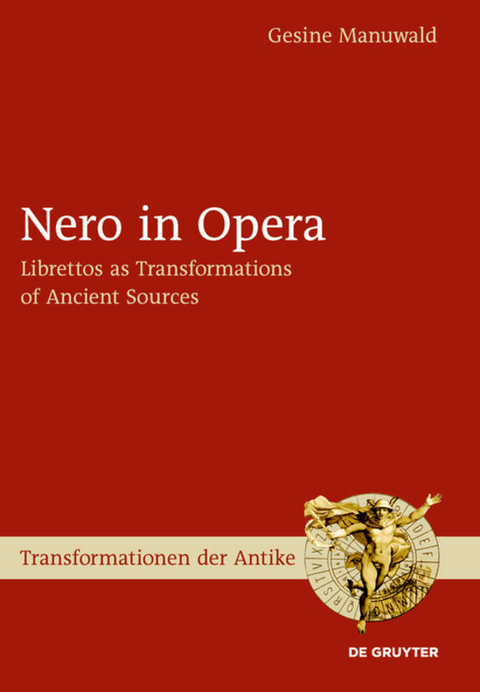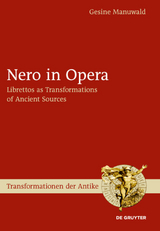Nero in Opera
Librettos as Transformations of Ancient Sources
Seiten
2013
De Gruyter (Verlag)
978-3-11-031713-8 (ISBN)
De Gruyter (Verlag)
978-3-11-031713-8 (ISBN)
Die Antike und ihre Rezeption wurden bisher weitgehend in den Grenzen von Fachdisziplinen erforscht. In der Reihe Transformationen der Antike steht dagegen die interdisziplinäre Kontextualisierung der produktiven Transformationen antiker Wissenschaften und Künste im Vordergrund. Dargestellt wird der langwellige, von der Spätantike bis zur Moderne reichende Prozess der Herausbildung des Wissenschaftssystems der Kunstgattungen und der kulturellen Selbstkonstruktion der europäischen Gesellschaften. Die Reihe geht hervor aus dem Sonderforschungsbereich „Transformationen der Antike“ und dem „August Boeckh-Antikezentrum“ an der Humboldt-Universität zu Berlin. Ihre Projekte untersuchen Transformationsprozesse insbesondere auf drei Ebenen: die konstitutiven Funktionen der Antike bei der Ausbildung der europäischen Wissenschaftsgesellschaft und ihrer Disziplinen; die Rolle der Antike bei der Entstehung mittelalterlicher, neuzeitlicher und moderner kultureller Identitäten; sowie die künstlerischen, literarischen, übersetzerischen und medialen Formen von Rezeption und Transformation.
This book considers the story of Nero and Octavia, as told in the pseudo-Senecan Octavia and the works of ancient historiographers, and its reception in (early) modern opera and some related examples of other performative genres. In total the study assembles more than 30 performative texts (including 22 librettos), ranging chronologically from L'incoronazione di Poppea in 1642/43 until the early 20th century, and provides detailed information on all of them. In a close examination of the libretto (and dramatic) texts, the study shows the impact and development of this fascinating story from the beginnings of historical opera onwards. The volume demonstrates the various transformations of the characters of Nero and his wives and of the depiction of their relationship over the centuries, and it looks at the tension between “historical” elements and genre conventions. The book is therefore of relevance to literary scholars as well as to readers interested in the evolution of Nero’s image in present-day media.
This book considers the story of Nero and Octavia, as told in the pseudo-Senecan Octavia and the works of ancient historiographers, and its reception in (early) modern opera and some related examples of other performative genres. In total the study assembles more than 30 performative texts (including 22 librettos), ranging chronologically from L'incoronazione di Poppea in 1642/43 until the early 20th century, and provides detailed information on all of them. In a close examination of the libretto (and dramatic) texts, the study shows the impact and development of this fascinating story from the beginnings of historical opera onwards. The volume demonstrates the various transformations of the characters of Nero and his wives and of the depiction of their relationship over the centuries, and it looks at the tension between “historical” elements and genre conventions. The book is therefore of relevance to literary scholars as well as to readers interested in the evolution of Nero’s image in present-day media.
Gesine Manuwald, University College London, UK.
| Erscheint lt. Verlag | 21.5.2013 |
|---|---|
| Reihe/Serie | Transformationen der Antike ; 24 |
| Verlagsort | Berlin/Boston |
| Sprache | englisch |
| Maße | 170 x 240 mm |
| Gewicht | 838 g |
| Themenwelt | Kunst / Musik / Theater ► Musik ► Klassik / Oper / Musical |
| Kunst / Musik / Theater ► Musik ► Musikgeschichte | |
| Geschichte ► Allgemeine Geschichte ► Altertum / Antike | |
| Schlagworte | Antike /Rezeption • Libretto • Nero • Nero Claudius Caesar • Nero; Octavia; opera • Octavia • Octavia, Kaiserin • Oper • Opera |
| ISBN-10 | 3-11-031713-3 / 3110317133 |
| ISBN-13 | 978-3-11-031713-8 / 9783110317138 |
| Zustand | Neuware |
| Informationen gemäß Produktsicherheitsverordnung (GPSR) | |
| Haben Sie eine Frage zum Produkt? |
Mehr entdecken
aus dem Bereich
aus dem Bereich




